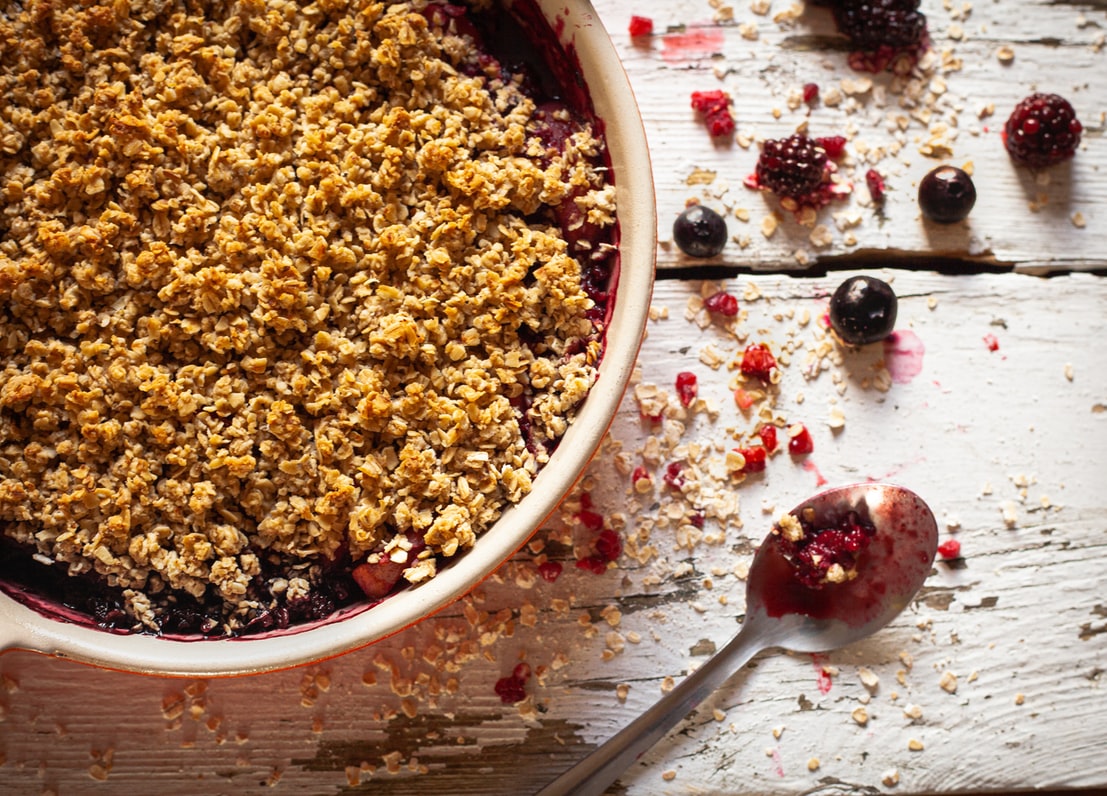Do you know any of these words that sound like a spell from a good old children’s tale – cobbler, kramble, crisp? Actually, they’re the names of American pies. They’re all like siblings from the same family: similar in some ways, yet different in others. There are other relatives as well.
Cobbler, kramble, crisp…
What these pies have in common is a theme beloved by modern cooks – seasonality. They are more than half made up of seasonal fruits, berries and sometimes vegetables – ingredients that a modern home-owner with a small garden will always have on hand. Besides, they are not cakes as we know them – there is not much dough in them, they do not play a major role and they usually have only a layer of dough on top. In short, you don’t need a rolling pin and dough processing skills. Accordingly, they don’t look very presentable. It’s the taste that counts.
When the first settlers from England reached America’s shores, they had to learn to improvise. After all, there were no familiar apples from the old orchards, no store of dried fruit, no handy stove… Everything strange and incomprehensible was growing around and somehow one had to manage to make a pudding for dinner out of it. It was all right, we used what we had and grew what we did not have. They put them into moulds and topped them with a dough made of leftover butter, sugar and flour – that’s the pie. The first colonists served them as a main dish, they acquired the status of desserts closer to the middle of the XIX century. Let’s deal with each one individually.
Crumble
Probably the most common pie outside the United States. Fruits or berries are placed in a well buttered mould and covered with a very crumbly pastry. The butter is not needed at all to keep the pie from sticking – there is no bottom layer anyway, just syrup. It is a very important ingredient and is largely responsible for the flavour of the crumble. A dough crumb made from a mixture of flour, sugar, butter and spices cooks up very quickly, so it is more important to bake the filling in this pie, especially the hard fruit.
Cobbler
Of all the fair company, this is the least like a pie. The filling of fresh fruit is topped with individual dumplings (aka ‘cobblers’) made from a soft dough with a dash of cream. Kobler is always served warm or even hot. While in the US it is made exclusively with fruit and berries, at home, in England, cobblers were made mostly with meat. It could be beef or turkey, most often with mushrooms, onions and spicy herbs. However, as far as modern Britons are concerned, cobbler is still a dessert – few people continue to bake meat-based versions. And for good reason – it tastes terribly good.
Crisp
Very similar to kramble: fruit yes crispy dough on top. The important difference is that the crumbly pastry always contains oat flakes. Also, in crisp, the filling should be crisp too, at least initially (apples, hard pears, quinces). Crisp is most often served warm.
Pandaudi
The filling in a pandaudi is always very juicy and even watery (mostly berries but can also be apples). This is the only pie for which you might need a rolling pin, because the dough, which is very similar to a classic minced pie, still comes flat on the filling. You can, however, shape it with your hands as well. First, bake the filling lightly with the sugar – so that it gives off the juice. Then the filling is covered with the pastry and baked until the pastry is ready, i.e. the top is crispy. Finally, break the crust gently into shape so that the crust soaks up the fruit juice, and serve it while the crispy-sweet edge is still not quite there.
Buckle
There are two kinds of pastry in this pie: the soft pastry, which you pour into the mold and dip the fruit pieces in it (it is the pastry that “bulges” in the oven so that the fruit is sunk into it), and the crumbly pastry on top – often called “streusel” in Austrian parlance. The streusel contains just a little bit of flour and/or nuts, a little butter, and lots of sugar.
Children usually fight to get the crumbs crumbling off the baked-to-brown streusel. Blueberries are the most popular filling for aubergines, followed by apricots and peaches.

